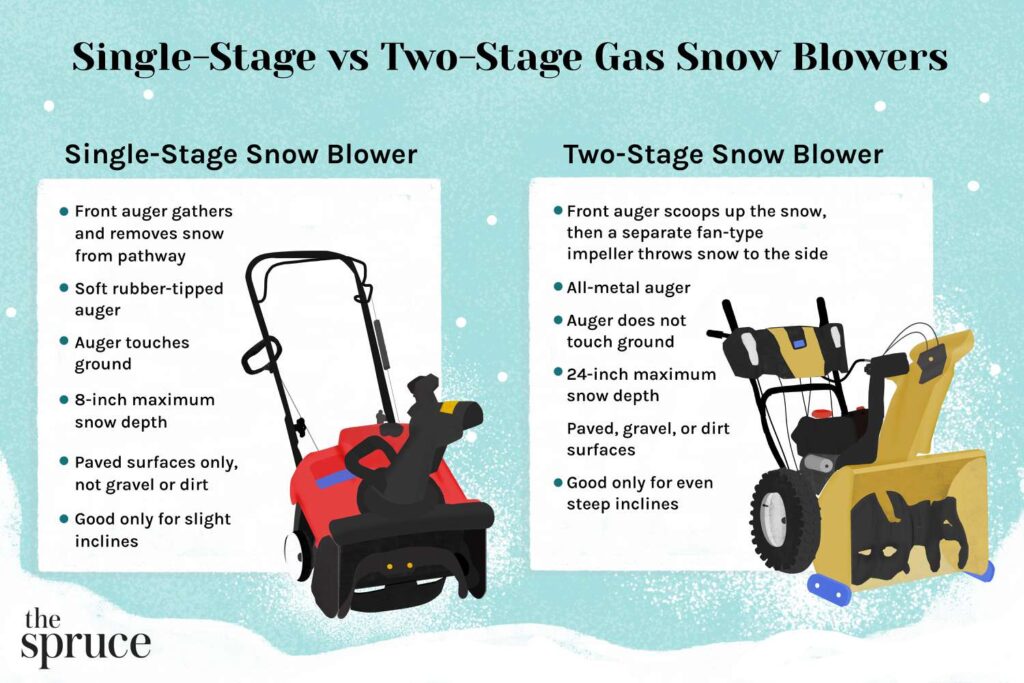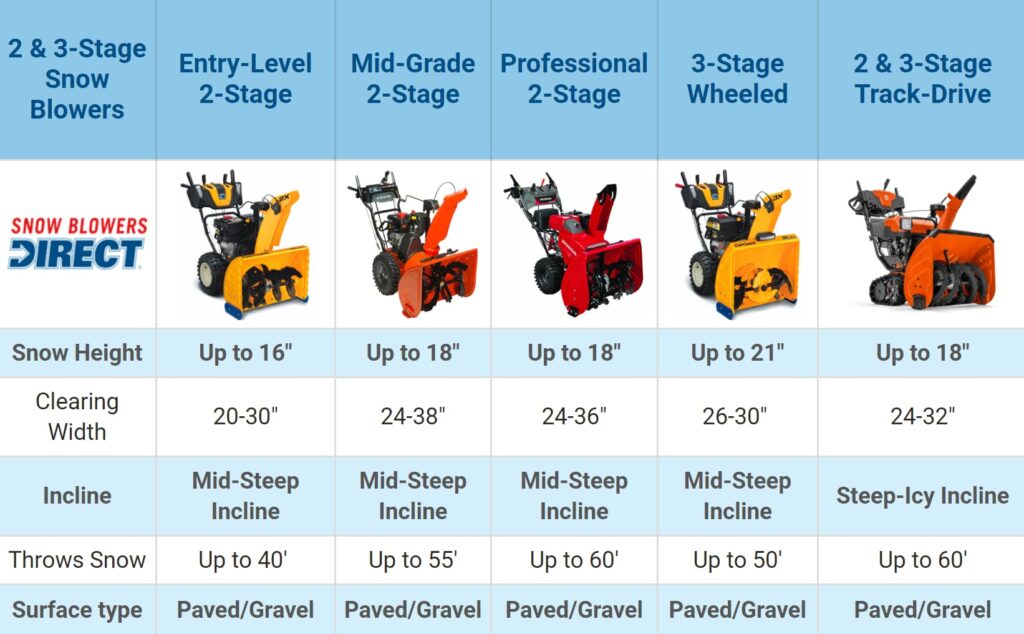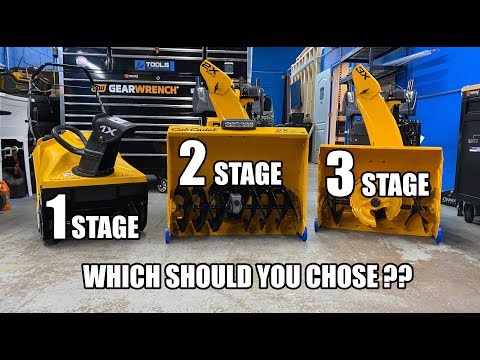In this article, we will explore the various types of snow blowers and discuss the key differences between them. We will explain what each stage refers to and how it affects the performance and capabilities of the snow blower. By the end, you will have a clear understanding of which type of snow blower is most suitable for your needs, whether it’s a 1 stage, 2 stage, or 3 stage snow blower. So let’s dive in and learn all about it!

This image is property of www.thespruce.com.
1 Stage Snow Blower
How does a 1 stage snow blower work?
A 1 stage snow blower, also known as a single-stage snow blower, is a compact and lightweight snow-clearing machine designed for smaller areas with lighter snowfall. It operates by using an auger, a spiral-shaped rotator, to scoop up the snow and propel it out of a discharge chute, clearing the path as it moves forward. The auger makes direct contact with the ground, which means it is not suitable for use on gravel surfaces.
Pros and cons of using a 1 stage snow blower
The main advantage of a 1 stage snow blower is its compact size and maneuverability. It is easy to handle and can navigate tight spaces, making it ideal for small driveways, sidewalks, and decks. Additionally, 1 stage snow blowers are usually more affordable compared to their 2 stage and 3 stage counterparts.
However, there are some limitations to using a 1 stage snow blower. Since it relies solely on the auger to clear the snow, it may struggle with heavy and wet snow as it lacks the power to throw it a far distance. Additionally, the auger is in direct contact with the ground, which means it may not be suitable for clearing icy surfaces as the auger can scrape and damage the pavement.
Best applications for a 1 stage snow blower
A 1 stage snow blower is best suited for homeowners with small to medium-sized driveways, walkways, and patios. It is perfect for regions with light to moderate snowfall, where the snow is dry and fluffy. It is not recommended for areas with frequent heavy snowfall or when dealing with icy conditions.
2 Stage Snow Blower
How does a 2 stage snow blower work?
A 2 stage snow blower is a more powerful and versatile machine designed to handle heavier snowfall and larger areas. It operates using two distinct mechanisms: an auger and an impeller. The auger, similar to that of a 1 stage snow blower, scoops up the snow and feeds it into the impeller. The impeller then propels the snow out of the discharge chute, throwing it a greater distance.
Pros and cons of using a 2 stage snow blower
One of the major advantages of a 2 stage snow blower is its ability to handle heavy and wet snow with ease. The combination of the auger and impeller allows it to clear larger volumes of snow and throw it farther away from the cleared area. Additionally, 2 stage snow blowers are equipped with more powerful engines, making them suitable for use on different terrain types, including gravel surfaces.
On the downside, 2 stage snow blowers are larger and heavier than 1 stage snow blowers, which can make them more difficult to maneuver, especially in tight spaces. They also tend to be more expensive compared to 1 stage snow blowers.
Best applications for a 2 stage snow blower
A 2 stage snow blower is most suitable for homeowners with larger driveways, long pathways, and commercial properties. It can effectively handle heavy snowfall and is designed to perform well in various conditions, including icy surfaces. It is a versatile machine that offers increased power and throwing distance, making it ideal for regions with frequent and heavy snowfall.
3 Stage Snow Blower
How does a 3 stage snow blower work?
A 3 stage snow blower is the most powerful and efficient type of snow blower available. It utilizes three mechanisms to effectively clear snow. The first stage is the auger, which gathers the snow and feeds it into the second stage, which is a high-speed impeller. The impeller then propels the snow into a third stage called an accelerator, which further breaks down the snow and throws it out of the discharge chute.
Pros and cons of using a 3 stage snow blower
The main advantage of a 3 stage snow blower is its exceptional snow-clearing capacity and efficiency. It can handle heavy snowfall, including wet and compacted snow, with ease. The addition of the accelerator ensures that the snow is propelled out of the machine at a high speed, allowing for greater throwing distance. 3 stage snow blowers are also designed to have wider clearing widths, reducing the number of passes required to clear a large area.
However, 3 stage snow blowers tend to be the most expensive option on the market, making them less accessible for some homeowners. Additionally, their larger size and weight can make them more challenging to maneuver, especially in tight spaces.
Best applications for a 3 stage snow blower
A 3 stage snow blower is best suited for homeowners or commercial property owners who frequently experience heavy snowfall and need to clear large areas efficiently. It is ideal for regions with consistently wet and heavy snow, as well as for use on gravel surfaces. The wide clearing width and powerful snow-clearing capabilities make it a top choice for those who prioritize speed and efficiency.
Performance Comparison
Snow clearing capacity of each type of snow blower
When comparing the snow clearing capacity of each type of snow blower, it is clear that the 3 stage snow blower outperforms the 1 stage and 2 stage snow blowers. The addition of the accelerator in the 3 stage snow blower allows for greater snow intake and throwing distance, making it the most efficient option for clearing large volumes of snow.
Throwing distance of each type of snow blower
The throwing distance refers to how far the snow is projected away from the cleared area. In this aspect, the 3 stage snow blower again offers the greatest throwing distance. With its powerful impeller and accelerator, it can throw the snow farther away, reducing the need for additional clean-up or clearing of the same area.
Efficiency and speed comparison of each type of snow blower
In terms of efficiency and speed, the 3 stage snow blower is the clear winner. With its wider clearing width and more robust snow-clearing mechanisms, it can clear a greater area in a shorter amount of time compared to the 1 stage and 2 stage snow blowers. This makes it the preferred option for individuals who value efficiency and want to get the job done quickly.

This image is property of www.snowblowersdirect.com.
Features and Functions
Differences in power source
All three types of snow blowers can be powered by either gas or electricity. Gas-powered snow blowers offer greater mobility and power, making them suitable for large properties and heavy snowfall conditions. Electric snow blowers, on the other hand, are more environmentally friendly, produce less noise, and require less maintenance. They are generally better suited for smaller areas and light to moderate snowfall.
Variations in clearing width
The clearing width refers to the width of the path that a snow blower can clear with each pass. Typically, 1 stage snow blowers have the narrowest clearing width, ranging from around 18 to 22 inches. 2 stage snow blowers have a wider clearing width, usually between 24 and 30 inches. 3 stage snow blowers offer the widest clearing width, often between 28 and 36 inches. The wider the clearing width, the fewer passes are required to clear a given area.
Adjustability and control options
Most modern snow blowers, regardless of the stage, offer various adjustability and control options. These may include adjustable auger and impeller heights, chute direction control, and variable speed settings. These features allow users to customize and optimize their snow clearing experience, ensuring that they can adapt to different snow conditions and terrain types.
Price and Maintenance
Cost range for each type of snow blower
When it comes to cost, 1 stage snow blowers are generally the most affordable option, with prices starting at around $200. 2 stage snow blowers are priced higher, typically starting at around $500. 3 stage snow blowers are the most expensive, with prices starting at around $1,000. It’s important to consider both the upfront cost and long-term value when deciding which type of snow blower to purchase.
Maintenance requirements for each type of snow blower
Maintenance requirements vary depending on the type of snow blower and its power source. Gas-powered snow blowers may require regular maintenance, including oil changes, spark plug replacements, and fuel system cleaning. Electric snow blowers generally require less maintenance, with routine checks and occasional lubrication being the main tasks. It is important to follow the manufacturer’s guidelines for maintenance to ensure the longevity and reliability of the snow blower.
Long-term durability and reliability
In terms of long-term durability and reliability, 2 and 3 stage snow blowers often have a slight advantage over 1 stage snow blowers. This is due to their more robust construction, powerful engines, and additional features. However, it is important to choose a reputable brand and properly maintain any type of snow blower to maximize its lifespan and performance.

This image is property of anestwithayard.com.
Choosing the Right Snow Blower
Considerations based on weather conditions
When choosing the right snow blower, it is essential to consider the weather conditions in your area. If you experience light to moderate snowfall, a 1 stage snow blower may be sufficient. However, for heavy and wet snow, or frequent snowstorms, a 2 stage or 3 stage snow blower is recommended.
Size of the area to be cleared
The size of the area to be cleared is another important consideration. For smaller driveways and pathways, a 1 stage snow blower may be adequate. However, if you have a large property or commercial space, a 2 stage or 3 stage snow blower will save you time and effort in clearing the snow.
Personal preferences and physical capabilities
Personal preferences and physical capabilities should also be taken into account. If you prefer a compact and lightweight machine that is easy to maneuver, a 1 stage snow blower is the way to go. However, if you value power and efficiency, and have the physical strength to handle a larger and heavier machine, a 2 stage or 3 stage snow blower may be a better choice.
Safety Tips
Operating procedures and safety precautions
When operating any type of snow blower, it is crucial to follow proper operating procedures and safety precautions. This includes reading the instruction manual, wearing appropriate safety gear such as goggles and gloves, and ensuring that the area to be cleared is free of obstacles and debris. Never attempt to clear a clogged discharge chute with your hands, and always shut off the snow blower before performing any maintenance or adjustments.
Recommended safety gear and attire
To ensure personal safety while operating a snow blower, it is recommended to wear goggles to protect the eyes from flying snow and debris, gloves to protect the hands from cold and possible injuries, and sturdy footwear with good traction to prevent slips and falls. Layered clothing and a hat are also advisable to stay warm in cold weather conditions.
Preventive measures for avoiding accidents
To prevent accidents, it is important to be aware of the surroundings and keep children and pets at a safe distance while operating the snow blower. Clear the area of any obstacles or hidden objects that may get caught in the machine. Avoid operating the snow blower on steep slopes or icy surfaces if it is not designed for such conditions. Regular maintenance and inspection of the snow blower will also help prevent any unexpected malfunctions.

This image is property of remingtonpowertools.com.
Environmental Impact
Effects on air and noise pollution
Gas-powered snow blowers contribute to air and noise pollution as they emit carbon dioxide and noise during operation. Electric snow blowers, on the other hand, produce zero emissions and are significantly quieter. Choosing an electric snow blower can help reduce your carbon footprint and minimize noise disturbance in your neighborhood.
Use of environmentally friendly features
Some snow blowers may offer environmentally friendly features such as LED lights, eco-mode, or automatic shut-off to conserve energy. These features can help reduce the environmental impact of snow clearing operations.
Eco-conscious snow clearing solutions
In addition to choosing an environmentally friendly snow blower, there are other eco-conscious snow clearing solutions that can be implemented. This includes using environmentally friendly ice melt products, minimizing salt usage to prevent water pollution, and considering manual snow removal methods such as shoveling for smaller areas to reduce energy consumption.
Conclusion
In conclusion, the difference between a 1 stage, 2 stage, and 3 stage snow blower lies in their size, power, and snow-clearing capacity. A 1 stage snow blower is suitable for smaller areas with light snowfall, while a 2 stage snow blower can handle heavier snowfall and larger areas. For heavy snowfall and maximum efficiency, a 3 stage snow blower is the best option. Factors such as weather conditions, area size, personal preferences, and budget should be considered when choosing the right snow blower. Regardless of the type chosen, following safety precautions, maintaining the machine properly, and considering eco-conscious practices will ensure a safe and efficient snow-clearing experience.

This image is property of i.ytimg.com.
